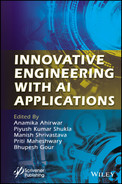Preface
This book presents a study on current developments, trends, and the future usage of artificial intelligence. The impending research on AI applications—like improvements in agricultural systems, security systems, web services, etc.—has shown the usefulness of AI in engineering, as well as in deep learning tools and models.
Engineering advancements, along with innovative applications of AI, span the gap between the physical and virtual world. The result is a hyper-connected society in which smart devices are not only used to exchange data but also have increased capabilities. These devices are becoming more context-aware and smarter by the day.
This book thoroughly explores the immense scope of AI in the above areas for productivity and the betterment of society and all of humankind. Rather than looking at the field from only a theoretical or practical perspective, this book unifies both aspects to give a holistic understanding of the AI paradigm. It focuses on timely topics related to the field of AI applications and combines new and high-quality research works that promote critical advances. Readers will appreciate the overviews of the state-of-the-art developments in emerging AI research.
This book takes foundational steps toward analyzing stress among teaching professionals using deep learning algorithms. Various deep learning models are discussed, with a practical approach that employs the MNIST dataset. These models help to solve various complex problems in the domains of computer vision and natural language processing.
Also introduced are some emerging and interdisciplinary domains that are associated with deep learning and AI. The book touches upon the core concept of deep learning technology, which is fruitful for a beginner in this area. Furthermore, it compiles the various applications of AI in agriculture, such as irrigation, weeding, spraying with sensors, and other means that are facilitated by robots and drones. This book covers most of the popular and important deep-learning neural network models.
The advanced fields of AI, data analytics, deep learning algorithms, etc., can help in the fight against environmental pollution. Additionally, this book discusses how people with severe disabilities can use their laptops, personal computer, or smart phones to communicate with greater reach. Low-cost systems such as HOG or machine learning models will help disabled people to attain improved typing skills, or even perform coding.
Artificial agricultural intelligence not only lets farmers automate their agriculture, it provides them with accurate predictions for greater crop yield and results in better quality, all while using fewer resources. AI and ML techniques help farmers to analyze land, soil, health of crops, etc. This saves time and money, and allows farmers to grow the right crop per season, ensuring optimal yield.
AI has potential to be used for planning and resource allocation by health and social care services. It can be beneficial across all health care sectors due to its different technologies. As such, AI should be viewed as an exciting new addition to the healthcare sector, not as a threat to professionals.
The cross-disciplinary field of AI research attempts to understand, model, and replicate intelligence and cognitive processes by invoking computational, mathematical, logical, mechanical, and biological principles. AI plays a major role in many sectors. With continual enhancement, it will improve the quality of our lives.
The editors wish to thank Scrivener Publishing and their team for the opportunity to publish this volume.
May 2023
